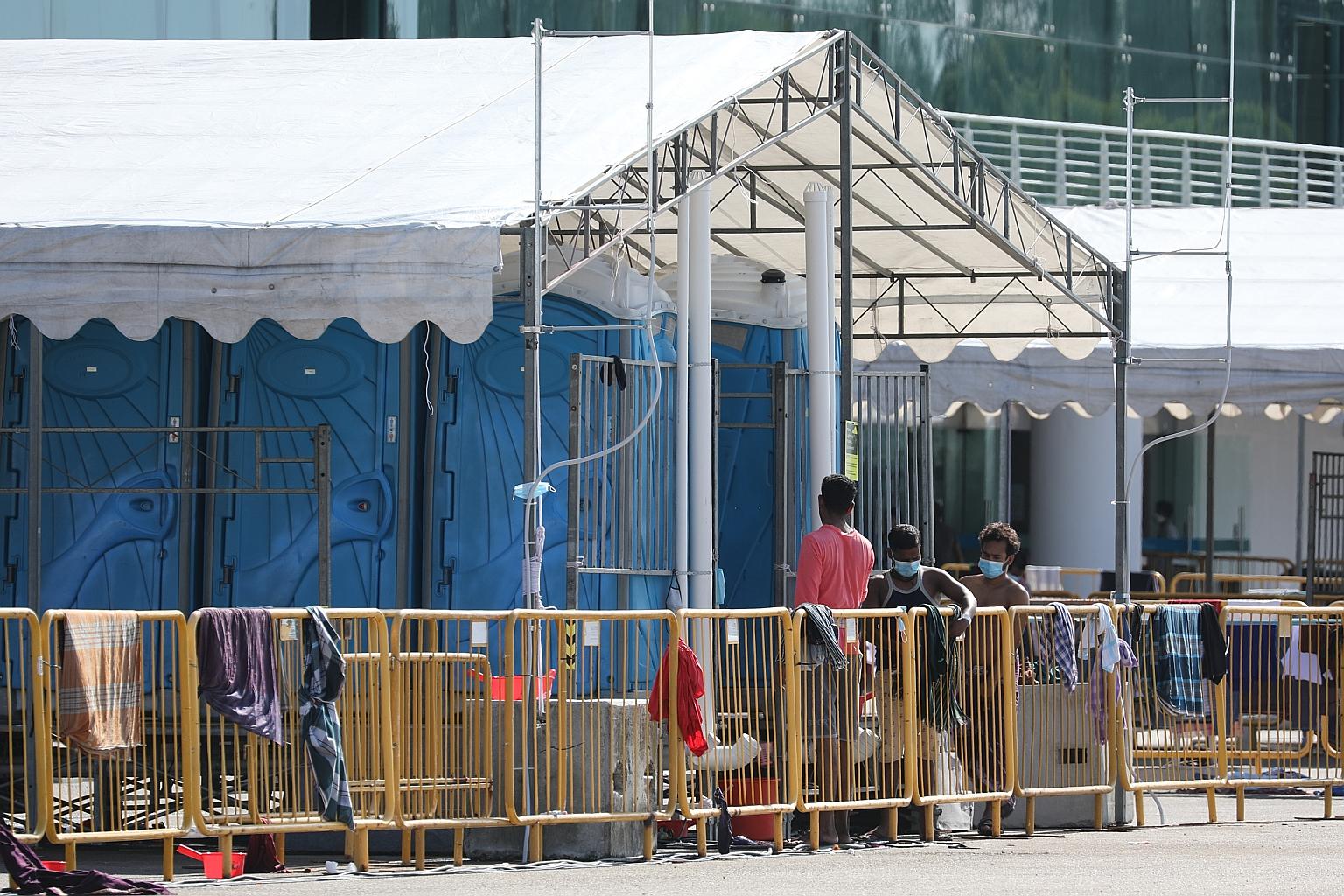Coronavirus pandemic
askST: What is being done to cut blood clot risks faced by Covid-19 patients?
Sign up now: Get ST's newsletters delivered to your inbox

Changi Exhibition Centre is among the community care facilities here that were caring for 10,600 individuals as of June 3, according to the Health Ministry.
ST PHOTO: ONG WEE JIN
Timothy Goh, Clara Chong
Follow topic:
On June 6, a 41-year-old Covid-19 patient died of a massive pulmonary thromboembolism, more than two weeks after he was discharged. The condition, which occurs when there is a blockage in a pulmonary artery located in the lungs, is caused by a blood clot that gets lodged in the artery. What is being done to reduce the risk?
The Straits Times answers this question and others posed by readers, including what a decrease in the number of Covid-19 patients in care facilities means for Singapore and how testing is conducted.
ON BLOOD CLOTS
Q: What is being done to prevent or reduce the risk of thromboembolism, or the obstruction of a blood vessel by a blood clot that formed elsewhere in the body, in Covid-19 patients?
A: Patients with severe Covid-19 infections are closely monitored, Dr Ling Li Min, a senior consultant at the National Centre for Infectious Diseases (NCID), said.
This includes monitoring with blood tests, and if clinical suspicion of thromboembolism is high, imaging studies - such as an ultrasound or a CT (computed tomography) scan - of the blood vessels in the lungs may be done.
Blood clot prevention measures like calf compressors or medications are also administered where necessary.
Q: Are Covid-19 patients monitored after they are discharged?
A: After discharge, patients who had experienced blood clots continue to be monitored with follow-up checks at sub-speciality medical clinics, Dr Ling said.
Those with Covid-19-related underlying medical conditions, such as pneumonia, low platelet count and abnormal liver function, are also monitored at infectious diseases outpatient clinics, he said.
Patients with chronic medical conditions such as diabetes, hyperlipidaemia and hypertension are also given follow-up appointments after they are discharged.
ON PATIENTS IN CARE FACILITIES
Q: How many patients are there in the care facilities now?
A: On June 6, there were 12,458 patients in care facilities. The number fell to 10,751 on Sunday.

-
AskST
If you have a question, e-mail us at askst@sph.com.sg
The daily average of new cases admitted is now about 400, compared with 1,426 at its peak on April 20, said Dr Matthias Toh, a consultant at NCID.
Future numbers in the care facilities will be a reflection of the number of new cases in Singapore's post-circuit breaker, Dr Toh said.
These care facilities include community care facilities (CCFs) - D'Resort, Singapore Expo, Changi Exhibition Centre, Tuas South - private hospitals as well as community hospitals.
The four CCFs, which can accommodate a total of about 12,800 people, were caring for 10,600 individuals as of June 3, the Health Ministry (MOH) said.
Q: Why have the numbers dropped?
A: It is not surprising that the numbers have dropped since the second half of last month, said Associate Professor Hsu Li Yang, who leads the Saw Swee Hock School of Public Health's infectious diseases programme. The number of cases, involving mainly foreign workers in dormitories, peaked around April 20 and then started to fall. Since most patients stay in these facilities for between two and three weeks, and with more patients being discharged than admitted, the fall was expected, he said.
Q: How low could these numbers possibly drop?
A: As the individual outbreaks at each dorm end or are contained, the daily number of new foreign worker cases in Singapore should eventually fall to the low double or even single digits. However, the situation in the dormitories remains complex, Prof Hsu said.
Also uncertain is how the gradual easing of work and other restrictions after the end of the circuit breaker period on June 1 will impact the infection rates, not just among the foreign workers, but also in the community, he added.
ON TESTING
Q: What are the Covid-19 tests being done?
A: MOH has relied mostly on swab tests using the polymerase chain reaction, which detects the genetic material of the virus. It is used to determine if someone is currently infected.
Another test, known as the serological test, detects antibodies to Covid-19 from a blood sample, which indicates possible past infection but is not effective for early diagnosis of an infection, MOH said. Patients usually develop a positive serology test only after more than 14 days.
Serology tests are therefore used more selectively, such as in public health research and epidemiological investigations, and to identify migrant workers with past Covid-19 infections.
Q: What is MOH's testing strategy?
A: Active case finding and surveillance testing of targeted groups - carried out through the vigilance of front-line doctors in looking out for individuals who fit the suspect case definition, and testing people with pneumonia.
Polyclinics and more than 340 general practitioner (GP) clinics are also testing all patients with prolonged acute respiratory infection.
Testing has also been expanded to individuals diagnosed with acute respiratory infection at first presentation to a doctor, starting first with seniors aged 65 and above, healthcare workers, as well as staff and older students in schools. Apart from targeted testing, random testing is also being done to pick up cases in the community that may otherwise go undetected.
As part of Singapore's influenza surveillance programme since 2007, samples are regularly collected from patients with influenza-like illness symptoms - such as fever and cough. These samples are obtained from GPs and polyclinics to test for common respiratory viruses. Since Jan 26, they have also been tested for Covid-19.

